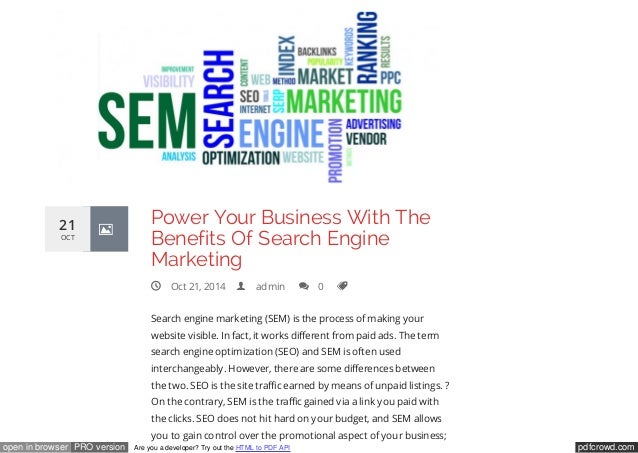1. How SEM Can Help Grow Your Business
Search Engine Marketing (SEM) is a powerful way to increase your visibility on the web and attract more customers. SEM consists of a variety of strategies that focus on improving your website’s visibility in the search engine results pages (SERPs). Through the use of keyword-based search campaigns, bid management services, and other techniques, you can ensure your business appears high up on relevant search engine queries and generates more leads.
Using SEM to attract customers to your business means you will be targeting potential customers that are already interested in what you have to offer. Through the use of precisely targeted campaigns and comprehensive reporting, you can evaluate and adjust your campaigns so that they are reaching the best prospects and generating leads from relevant traffic. SEM also helps you advertise new products or services, helping to boost sales and increase customer conversions.
Native Advertising is one highly effective form of SEM, where ads are placed directly in the SERPs which feature a design that’s similar to the organic search results and query intent. Native ads allow for more control over who sees your ads, as well as better branding opportunities when users see your business in search results.
With beneficial keyword research, careful analysis of competitors’ data, and an understanding of user intent, SEM can most definitely help grow your business by generating more leads and providing more opportunities for sales. SEM lets potential customers know that you are relevant with regards to what they are looking for while improving visibility and creating a larger website reach.
2. Understanding the Basics of SEM Services: What You Need to Know
Search engine marketing (SEM) is a type of online marketing strategy which focuses on increasing the visibility of webpages in search engine results pages (SERPs) for the purpose of attracting potential customers. It’s a broad term which covers a range of strategies from organic search engine optimization (SEO) to paid ads such as pay-per-click (PPC). By adopting effective SEM strategies, businesses can enhance their visibility and maximize the impact of their online marketing campaigns.
When it comes to understanding SEM services, it’s important to recognize that there are several core components which form the foundation of SEM optimization. These include:
1. Keyword Research & Analysis: The process of analyzing and identifying the most relevant keywords related to your business in order to optimize your page content and achieve greater visibility and ranking in SERPs.
2. Content Optimization: Making sure that all webpages are optimized for the best possible performance in terms of search engine indexation, usability, and visibility. This includes ensuring that all titles, meta descriptions, headings, and images are SEO friendly.
3. Link Building: Creating high quality links from external websites to pages on your website in order to build up your website’s authority with search engines and drive organic traffic.
4. Paid Advertising & Promotions: Implementing targeted paid advertisements on relevant networks such as Google Ads and Microsoft Advertising in order to ensure maximum visibility for your website and increase qualified traffic.
By using the combination of these strategies, businesses can take their online presence to new heights and get the most out of their digital marketing campaign.
3. Exploring the ROI of SEM Services
Search engine marketing (SEM) is an important part of any company’s overall marketing strategy. SEM services, like paid search advertising and organic search engine optimization, can help boost brand visibility and generate high-quality leads for your business. While the benefits of SEM are evident, many marketers are hesitant to invest in SEM services due to uncertainties about the return on investment (ROI) these services may deliver.
Organic search engine optimization can deliver great results when done correctly, but takes time to produce long-term payoffs. For businesses with shorter timelines, or greater immediate needs, a paid search strategy is key to achieving successful ROI. Paid search delivers a steady influx of traffic to your site, which can be seen within days, not months or years. Pay-per-click (PPC) ads allow businesses to target users who are actively searching for certain keywords related to your product or service offering. This means you can easily identify and target the most qualified prospects by investing in the keywords that guarantee you’ll get the best bang for your buck.
SEM can be expensive so it’s important to make sure you’re getting the most out of your money by tracking and analyzing your results over time. There are many metrics available to measure your success such as click-through rates, cost-per-click, and impressions. It’s important to develop a comprehensive strategy that focuses on both short-term and long-term goals to ensure success from your SEM efforts over time. An effective SEM strategy should take into account factors like budget, competition, industry trends, and even location — as this will inform when and where you should be investing in ads.
Though it can be a challenge to accurately predict ROI from SEM services without testing and tweaking your efforts over time; with an effective strategy and enough optimization and tracking, understanding the return on investment of SEM services becomes easier. By taking into account the targeted market, budget and preferences, businesses can determine what keywords are most likely to drive conversions and develop a paid search campaign that meets their needs. Taking advantage of this knowledge can help drive positive results for your business and make SEM services worth the investment.
4. Crafting an Effective SEM Strategy for Your Business
Search Engine Marketing (SEM) is a powerful way to generate leads, increase brand visibility, and grow your business. An effective SEM strategy takes research and forecasting of results, when done correctly it will build a strong foundation to help you achieve the desired outcomes.
In the first step of creating an effective SEM strategy, you’ll need to take an in-depth look at who your target audience is and the potential keywords they could use to search for your business. Once you’ve identified the keywords that your target audience is likely to use, you can focus on the paid search opportunities supported by your search engine. Popular options include Google Ads and Bing Ads, but there are many more available depending on your budget and industry requirements.
The next step is to set a budget for your SEM campaign. You will need to decide how much money you can invest into various paid search campaigns each month while still being able to measure success with meaningful data. It’s important to consider content marketing, organic SEO efforts, and any other promotion methods that are currently in use alongside your SEM strategy. The key is to make sure your overall marketing spend is calculated so that it will yield maximum results.
The third step is to craft compelling ads for your SEM strategy. You’ll need to ensure that you are creating ads that not only stand out from competitors but also appeal to searchers in order to maximize relevance and subsequent click-through rate (CTR). Tailoring your ads specifically to each of your target audiences will be especially beneficial as you will be able to convey different messages for each audience segment.
Finally, you should use robust tracking and reporting mechanisms in order to measure the performance of your SEM activity. By examining cost-per-click (CPC), click-through rates (CTR), cost per acquisition (CPA), return on ad spend (ROAS) and other relevant data points, you will be able to make more informed decisions moving forward and optimize campaigns more efficiently. This can also help reduce wasted spend by identifying dead end campaigns or keywords so they can be adjusted or eliminated if necessary.
To get the most out of your search engine marketing strategy, it’s important to be thorough at each step of the process – researching target audiences, setting budgets, creating compelling ads, and tracking performance. When done correctly, an effective SEM strategy will attract more leads and help generate greater ROI for your business.Image sources:https://apollo.agency/blog/what-is-sem-and-why-is-it-necessary-for-travel/ – https://www.slideshare.net/Debbie456/benefits-of-sem






2 thoughts on “How SEM Can Help Grow Your Business”
SEM, also known as search engine marketing, can be a powerful tool to help grow your business. By using targeted keywords and advertising on search engine platforms like Google, you can increase your online visibility and reach a larger audience. SEM allows you to appear at the top of search engine results, driving traffic to your website and potentially converting leads into customers. It’s a strategic approach that can provide measurable results and contribute to your business growth. Give it a try and see the impact SEM can have on your business! i saw your How to Use an Automated Backlink Generator to Improve Your SEO!!
SEM, or Search Engine Marketing, is a powerful tool that can greatly benefit businesses by increasing online visibility and driving traffic to their websites. By targeting specific keywords and optimizing ad campaigns, SEM can help businesses reach their target audience more effectively. Additionally, SEM allows businesses to track and analyze the performance of their campaigns, enabling them to make data-driven decisions and improve their overall marketing strategy. Overall, SEM is a valuable asset that can help businesses grow and thrive in today’s competitive digital landscape. i saw your Utilizing A Video SEO Consultant To Unlock Your Video Content’s Potential!!